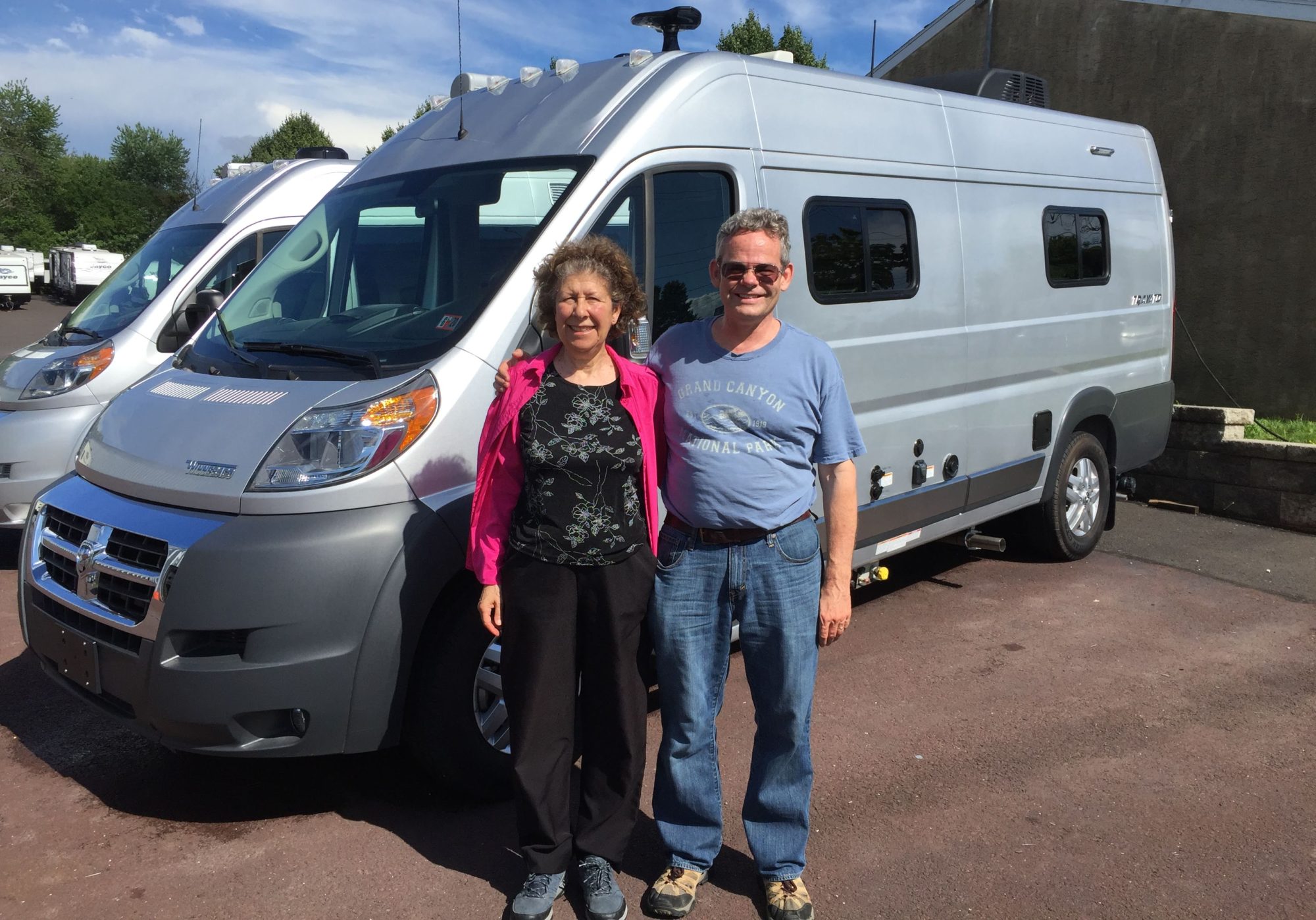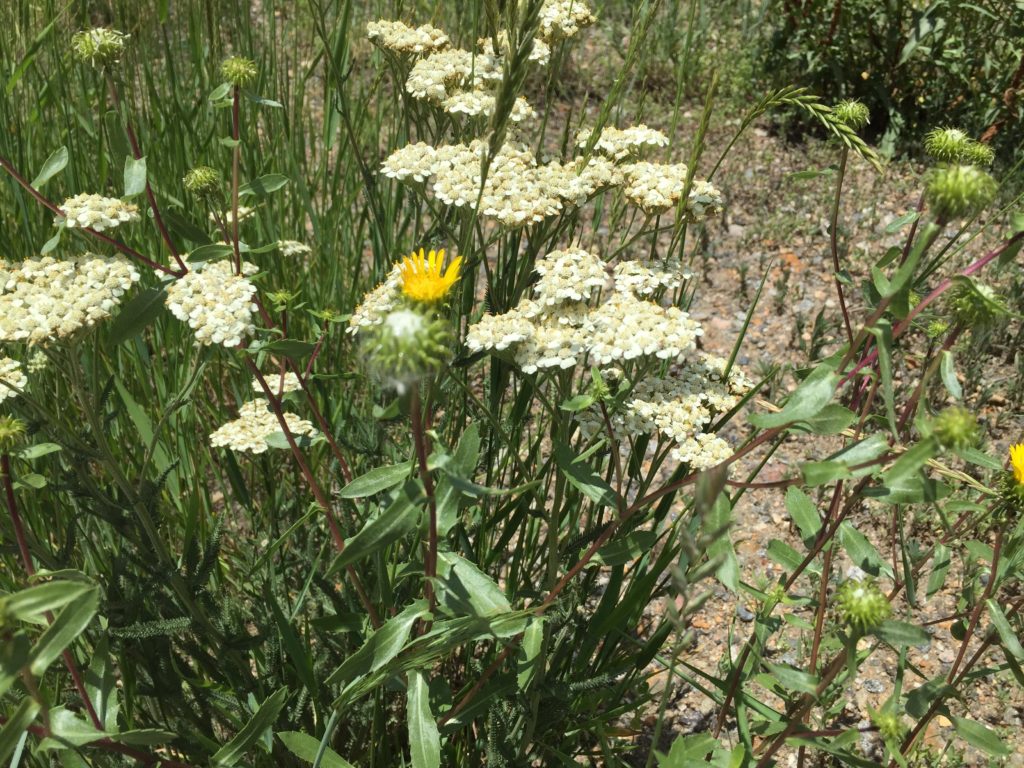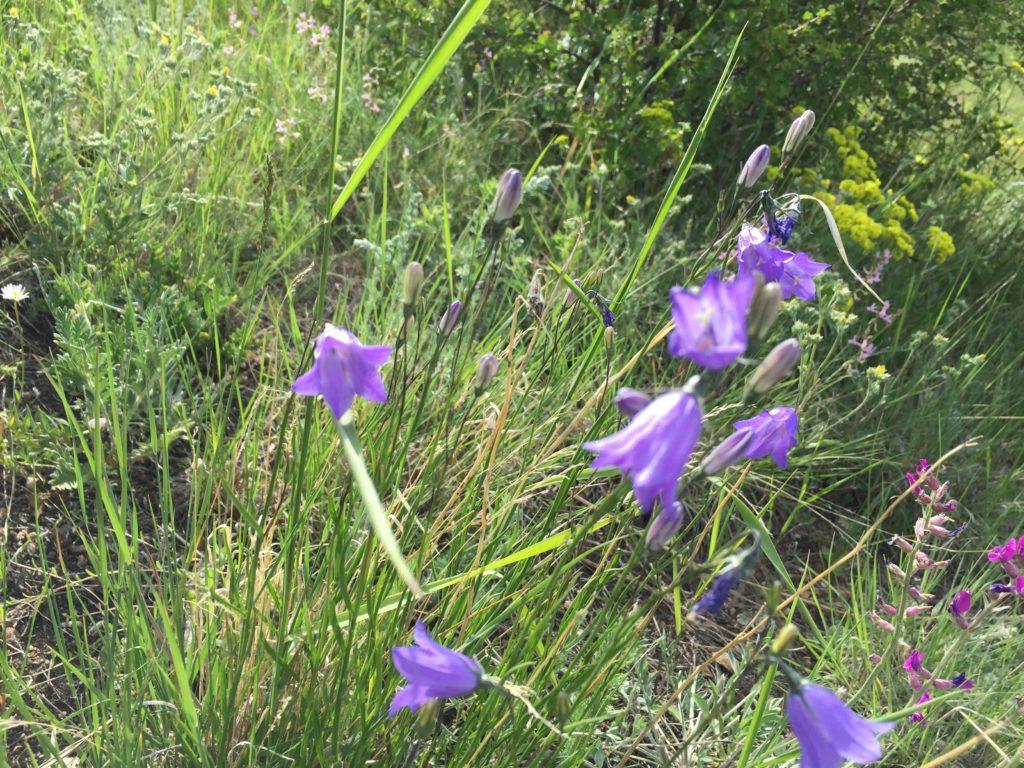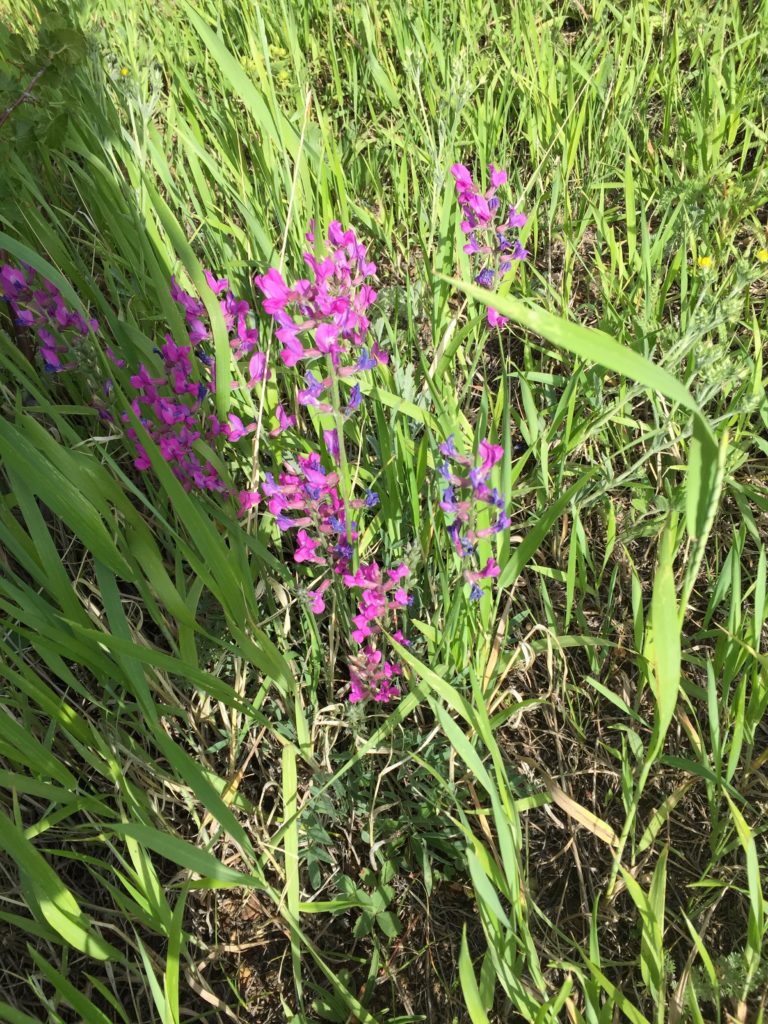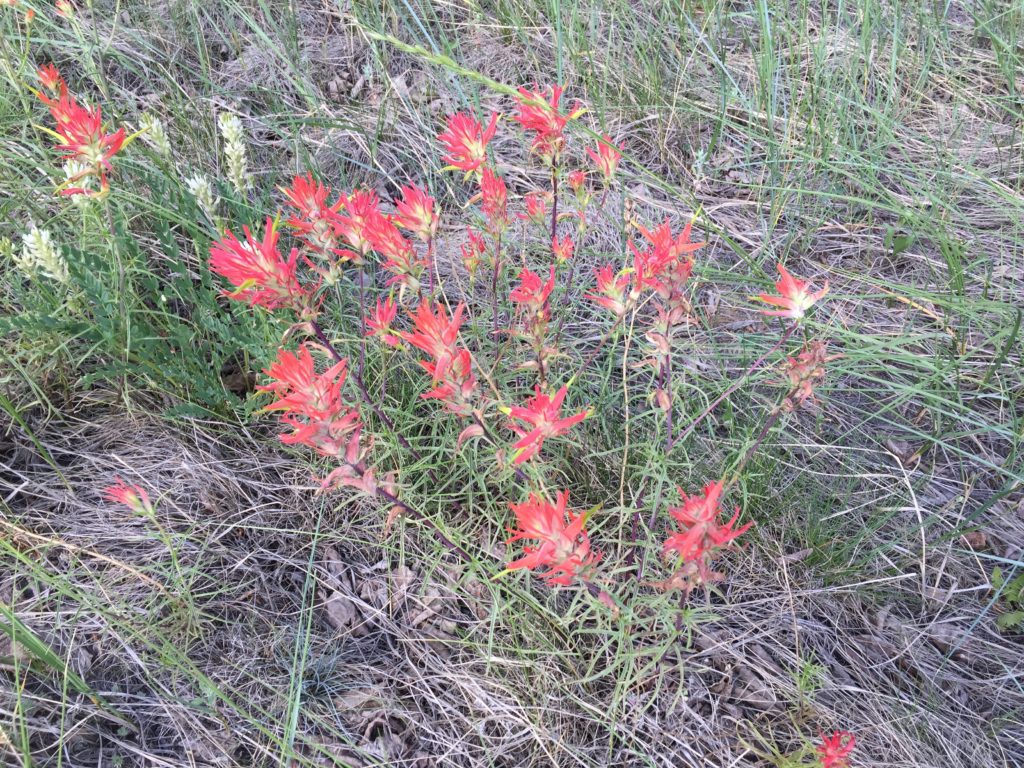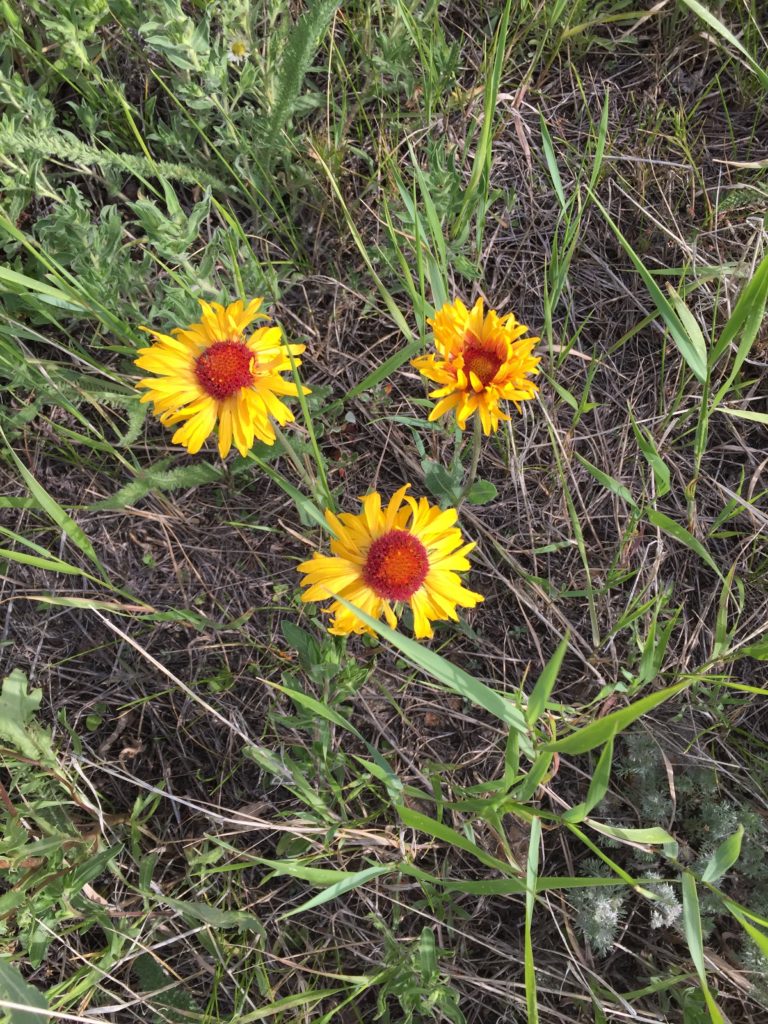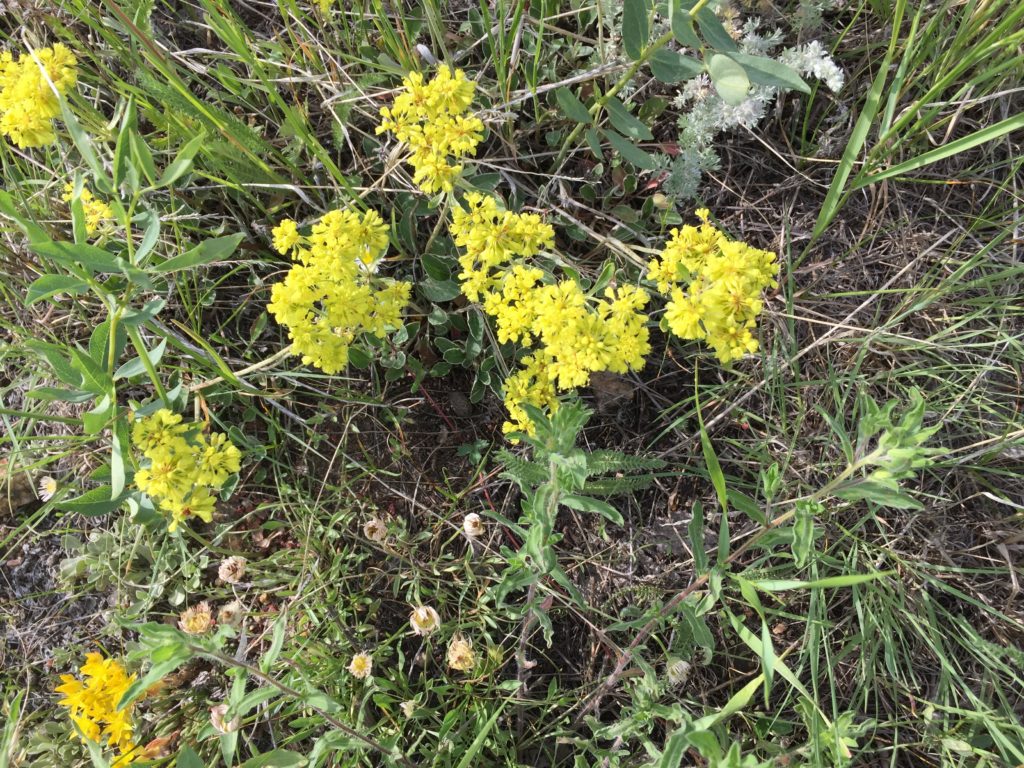July 17 – 22 Colorado
Western Kansas is flat prairie with wheat and corn fields as far as the eye can see. No fracking wells. Not surprisingly, eastern Colorado is much the same. However, a few hours of driving brought us to rolling foothills and then Denver.
Considering that it was midday when we got to Denver, traffic was very dense. However, just west of Denver, the traffic clears out and the road begins to climb.
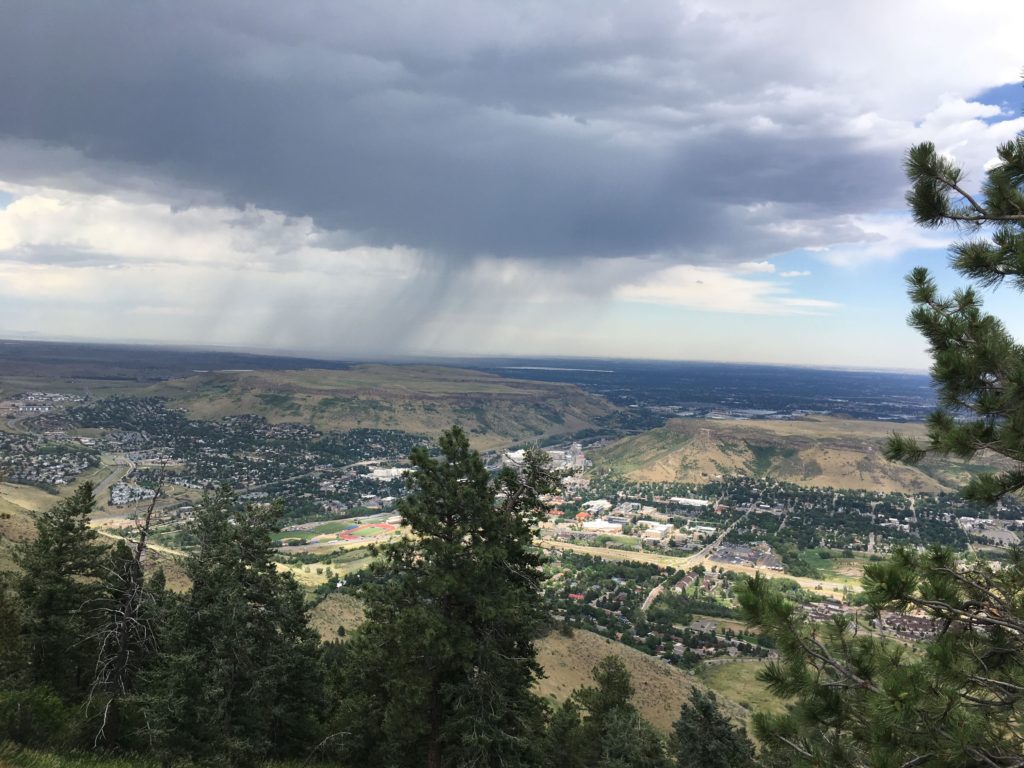
We were attracted by a sign pointing to Buffalo Bill Cody’s grave and museum, so we cut off the road and climbed (by van) up aptly named Lookout Mountain. From the top, there is a great view of Denver and of Golden (home of Colorado School of Mines).
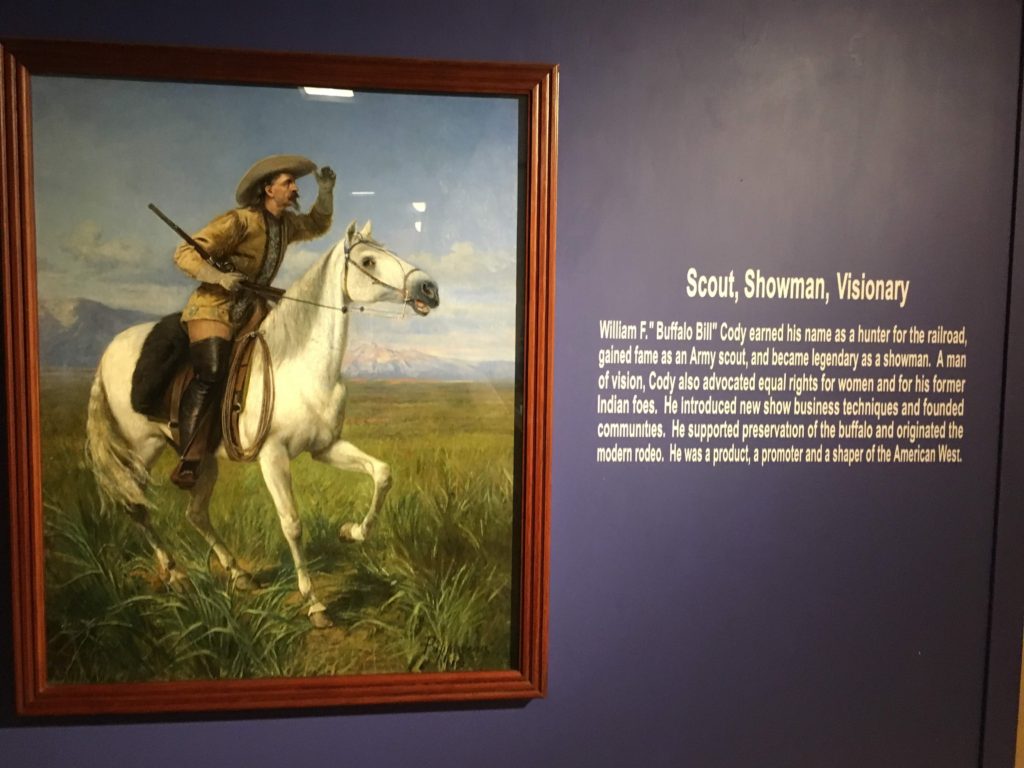
Buffalo Bill helped build the myth of the American West. He was a scout, bison hunter, Pony Express rider and most famously, showman. He famously staged enormous pageants of western life first in the US and Canada, and later in Europe, bringing with bison, horses, cowboys, sharp-shooters and entire families of Native Americans. (It seems possible that the Pony Express, which was active for only 18 months, would not play such a big part in the myth of the west had Buffalo Bill not referred to it in his pageants. Other famous names in the show included Annie Oakley, her husband Frank Butler, Wild Bill Hickok and Sitting Bull.
Interestingly enough, Buffalo Bill was ahead of his time in many things. He offered equal wages to his Indian and women employees. He encouraged the audience to actually meet the families of the Indians as a means of encouraging empathy with the plight of the many tribes who had been evicted from their land. He testified in favor of the Indians in the US courts. And, as an employer of several talented women sharpshooters, he promoted enfranchisement for women. He was also a conservationist who felt that hunting should be regulated.
Buffalo Bill’s father was from Toronto (Mississauga, to be exact) and he spent part of his early life there, although Bill was born in Iowa. The family then moved to Fort Leavenworth, where their abolitionist activism put them in danger. The father died when Bill was 11 from complications due to a knife attack from pro-slavery supporters. As a result, Bill had to go to work to help support the family. At this early stage in his life he participated on the US side in the Mormon Rebellion, a confrontation between the US government and the Mormon settlers. This rebellion led directly to the formation of the Pony Express.
He achieved a certain amount of fame due to novels and stories published about his adventures by Ned Buntline and later other writers. He decided to exploit his fame by creating Buffalo Bill’s Wild West. He later expanded it to include skilled horsemen (and women) from around the world. This was quite a spectacle at the turn of the 20th century. In 1901, a freight train crashed into the train carrying the show. Although no human lives were lost, the loss of 110 horses and the sets created a financial loss from which the show did not recover, although it did do a European tour around 1907.
He died in Denver, and apparently told friends and immediate family members that he wished to be buried on Lookout Mountain. However, in his will, he stated that he wished to be buried in Cody, Wyoming. This discrepancy has led to some controversy.
I note in passing that as was frequently the case in the “good old days” 2 of Bill’s 4 children died in childhood and only one survived him.
From Lookout Mountain, we continued a few miles to the KOA in Blackhawk. This KOA was pleasant enough, although it primarily serves the casinos in Center City. The main thing, from our perspective, is that it was 15F cooler than any place we had been further west.
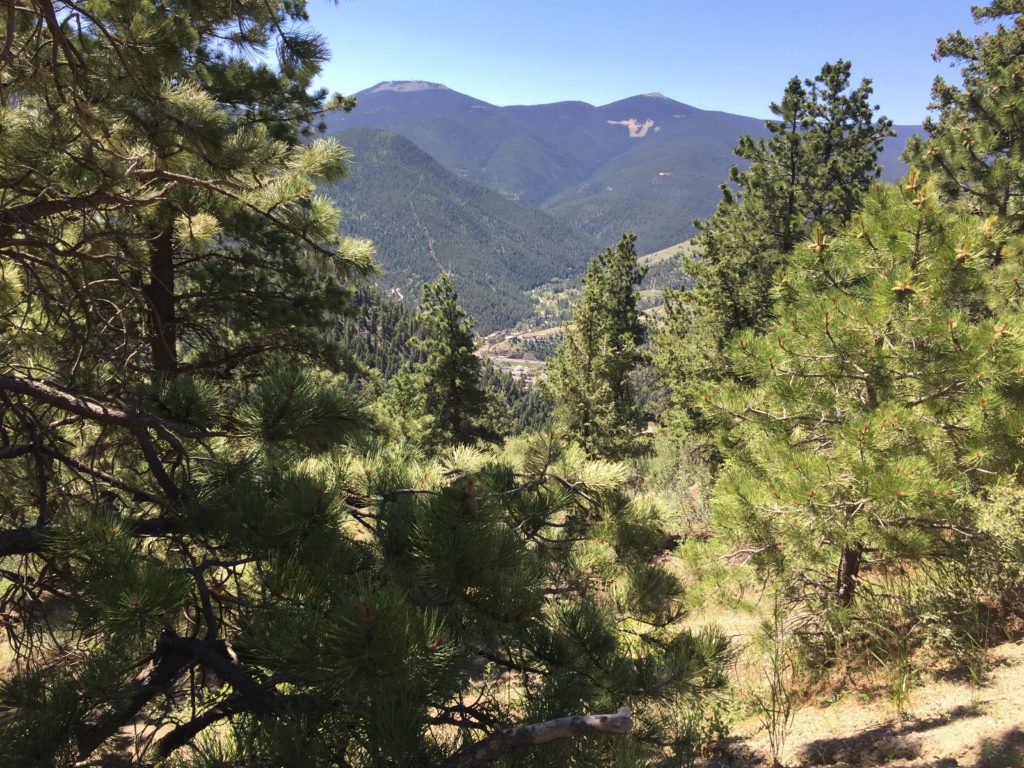
We used Blackhawk as our anchor for exploring the local mountains and mining towns. Although highway 70 goes through many of the main towns, we started off on Wednesday by taking the infamous Virginia Canyon Road (VCR) to Idaho Springs, the largest town in the area and the origin of the Colorado Gold Rush. VCR follows the rim of Virginia Canyon, a very steep and deep canyon. On this first attempt to traverse the road, we followed Google Maps, which led us down Two Brothers Road (named after the Two Brothers Mine). This is a very rough and very steep gravel road that quickly descends to the canyon floor and Idaho Springs. On Friday, we did the traverse properly along the hard-packed dirt road that clings to the top and sides of the canyon. Most of the road is 1.5 lanes, with blind hairpin curves and no guardrails. Much of the roadside is so steep (and treeless) that a car going over the edge would plunge several hundred feet to the bottom (and the downhill side of the road was also eroded in some spots). The views were breath-taking, but I don’t think we would do this again.
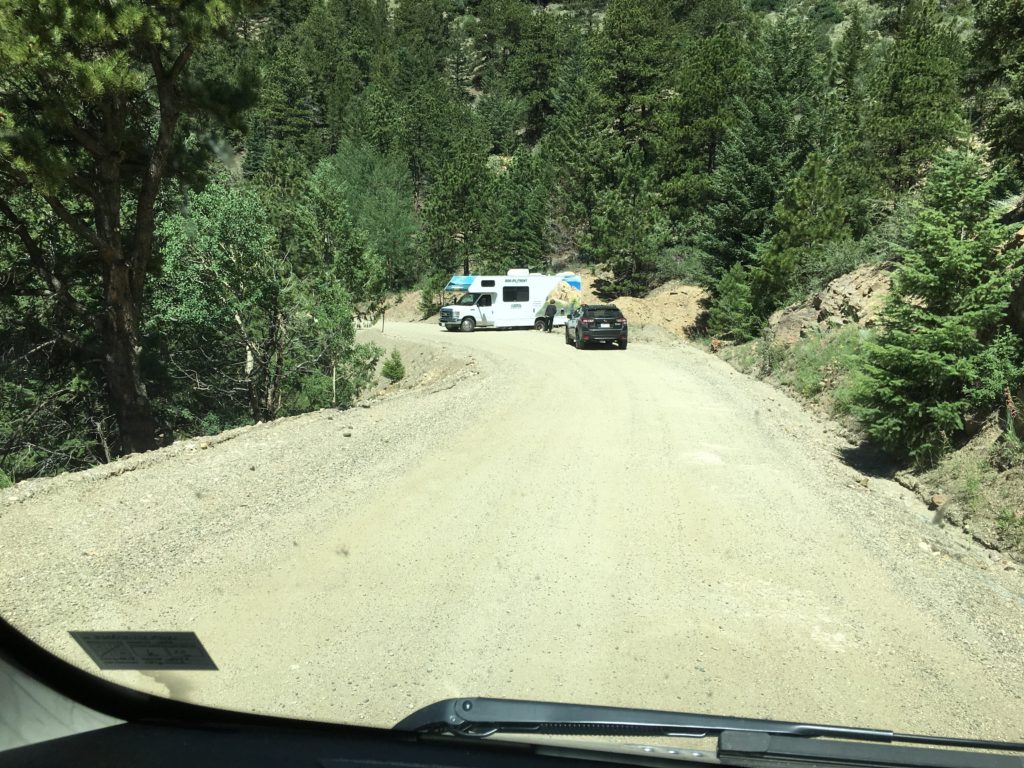
At one point, we met a hapless tourist with a rental RV, stuck with his rear wheels in the ditch and his vehicle at 90 degrees to the road. He had decided not to take the road, and had picked a pull-out to do a 3 point turn, not realizing that on the uphill side of the road was a sandfilled ditch. We doubted that the could accelerate out of the ditch without putting his front wheels over the other side of the road (the scary side, although it was a bit less steep and better treed there). In any case, the pullout was wide enough for us (and others) to get around him, so we left him there to wait for a tow truck. I suspect there is a tow company in Idaho Springs that subsists on pulling tourists off VCR.
The Colorado Rockies are in bloom. I have never seen so many wildflowers. I will be posting lots of flower pictures in the coming posts.
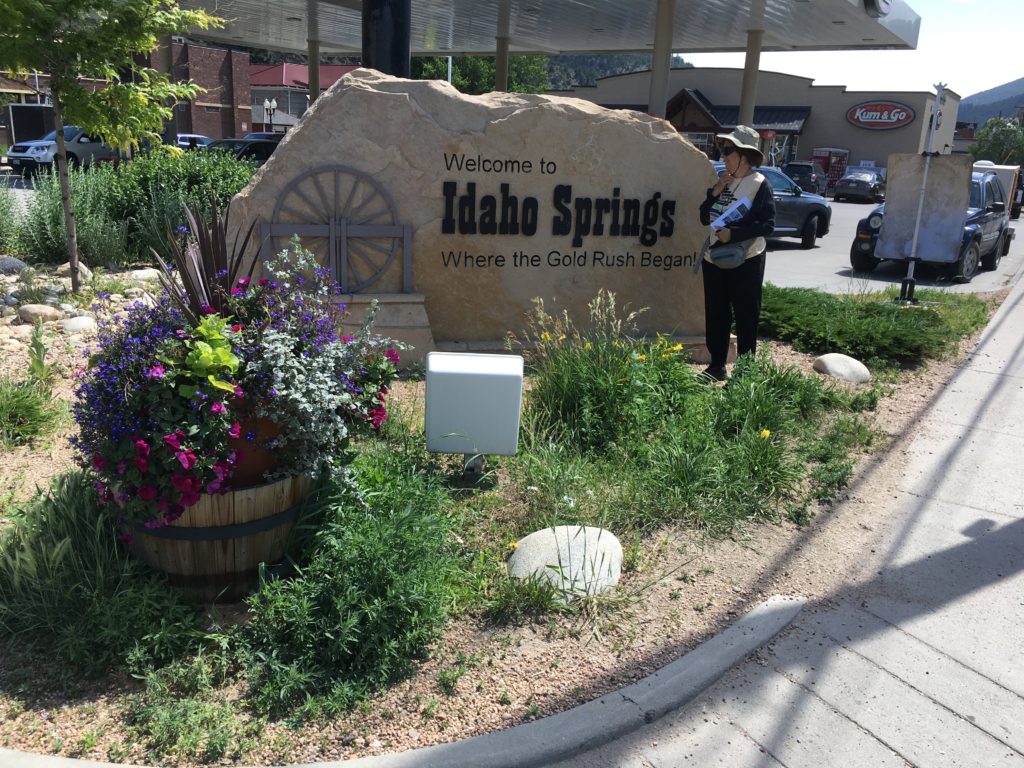
On Wednesday we stopped in Idaho Springs and walked through the historic downtown. We then walked along Clear Creek, a river that is heavily used for white water rafting. We watched rafts, had a look at a historic waterwheel that had been used as part of a mining operation, and looked at the many beautiful blooming wildflowers.
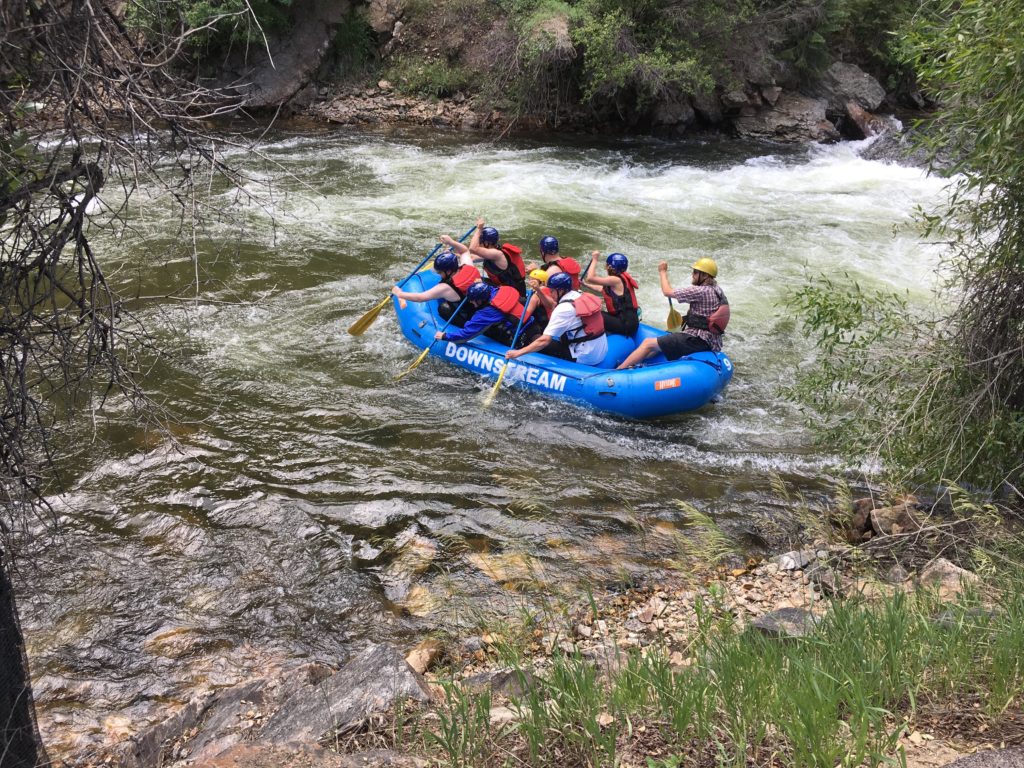
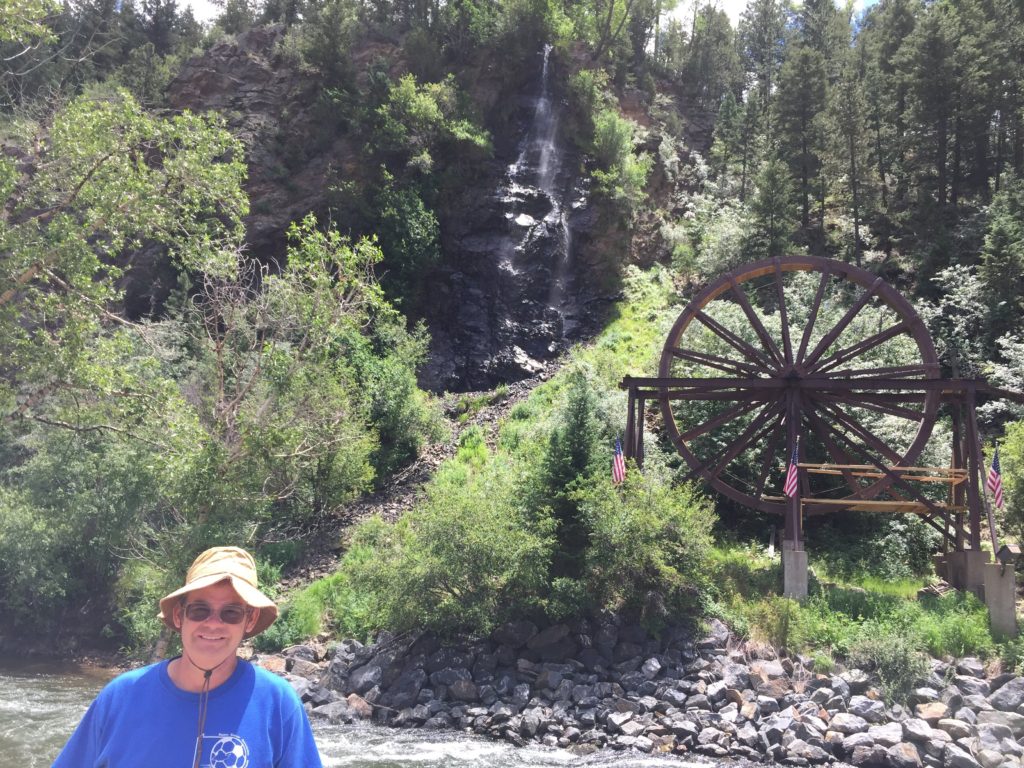
We then drove to the historic town of Georgetown and walked through its downtown. Georgetown is also home to one of the largest bighorn sheep herds in the area. We stopped at the viewing area but were disappointed.
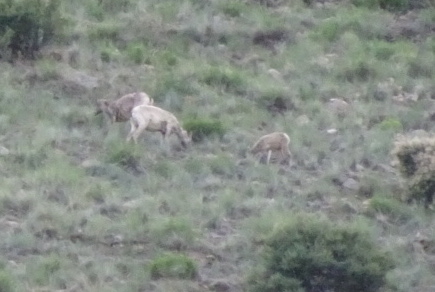
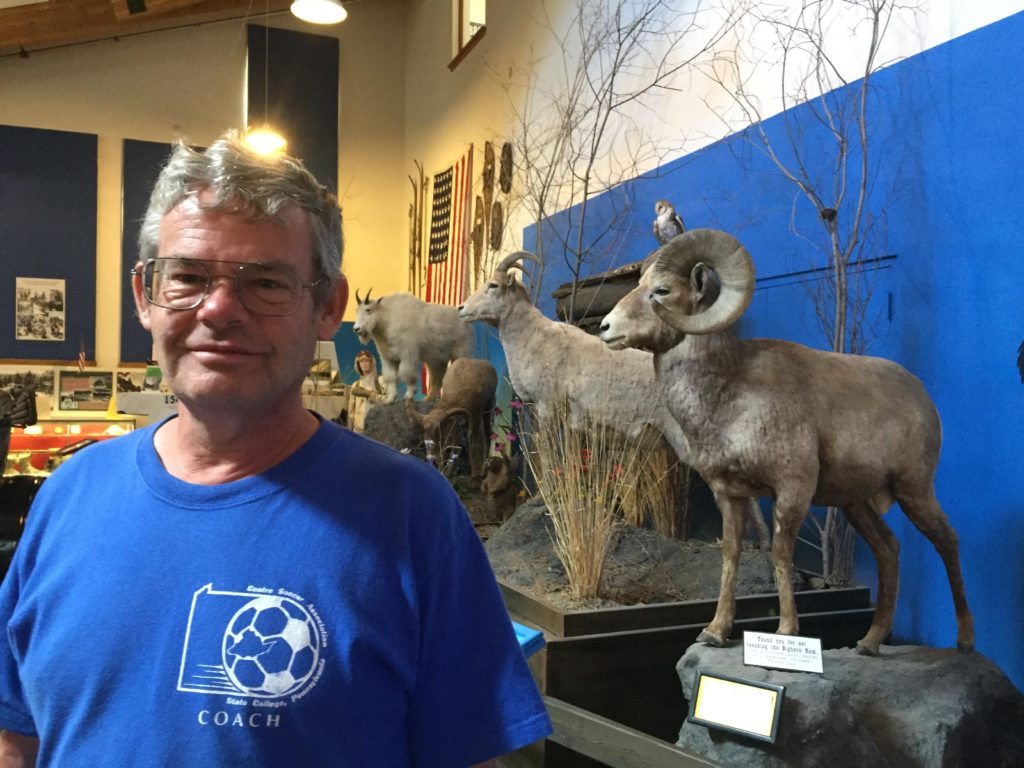
However, on Thursday, we stopped again and were rewarded by sighting 2 families of grazing sheep. Binoculars are required for this exercise.
When we returned to the campground, we were surprised to see that our immediate neighbors were a family of 4 with 3 dogs in a camper van. We could not see how they all fit in! Actually, they had just dropped a son at the Airforce Academy, so there had been 5 of them in the van. It turned out that this was a conversion van – a regular van that the father of the family had converted for camping. The interior was all seating and sleeping — no kitchen or bathroom. They had done a great job.
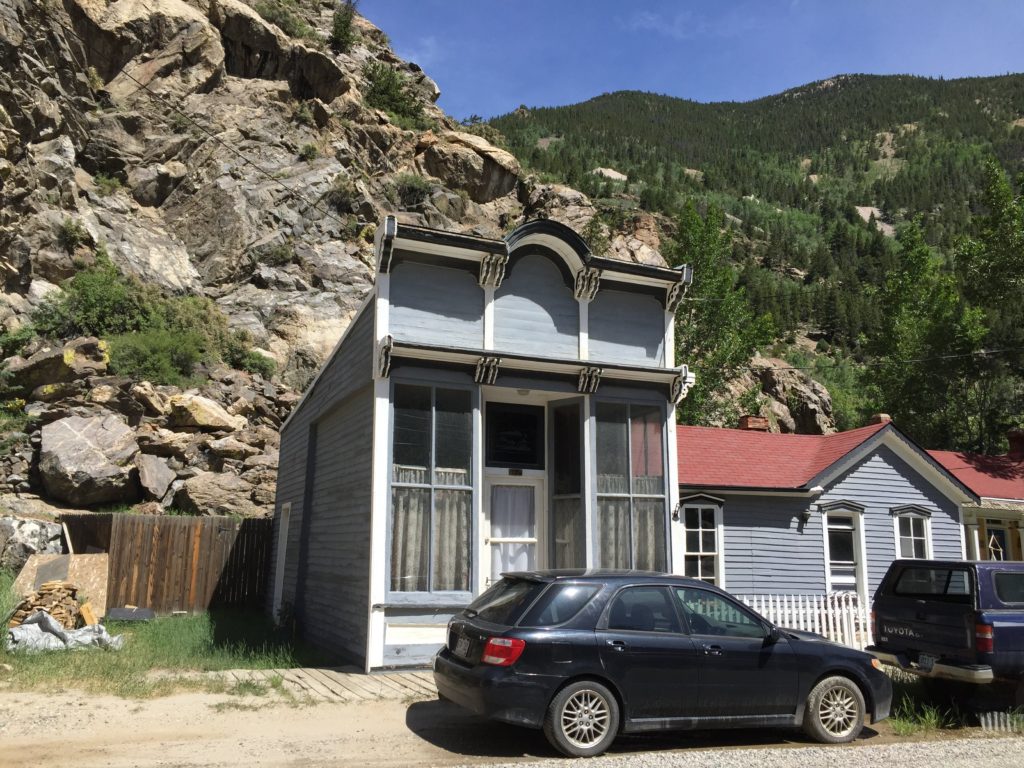
On Thursday, we took the VCR to Idaho Springs and then took a brief look at Silver Plume, one of the old mining towns. It is tiny, and seems to be hanging on due to the tourist trade. It is pretty though, with Clear Creek (the rafting creek) running through it and flourishing gardens.
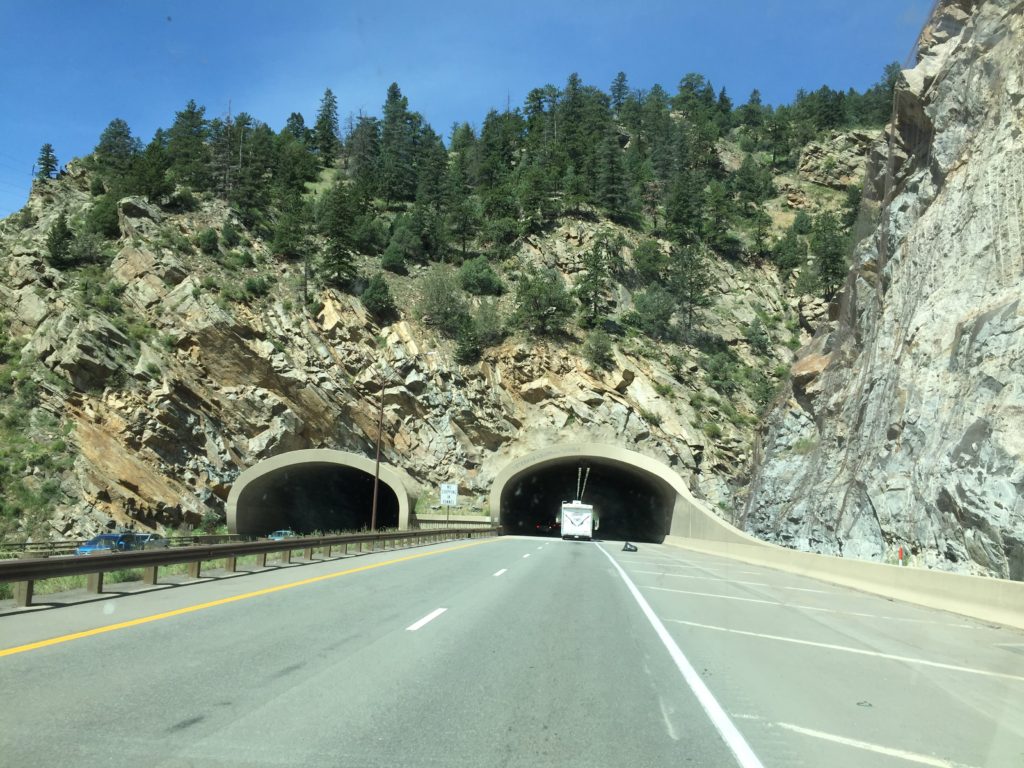
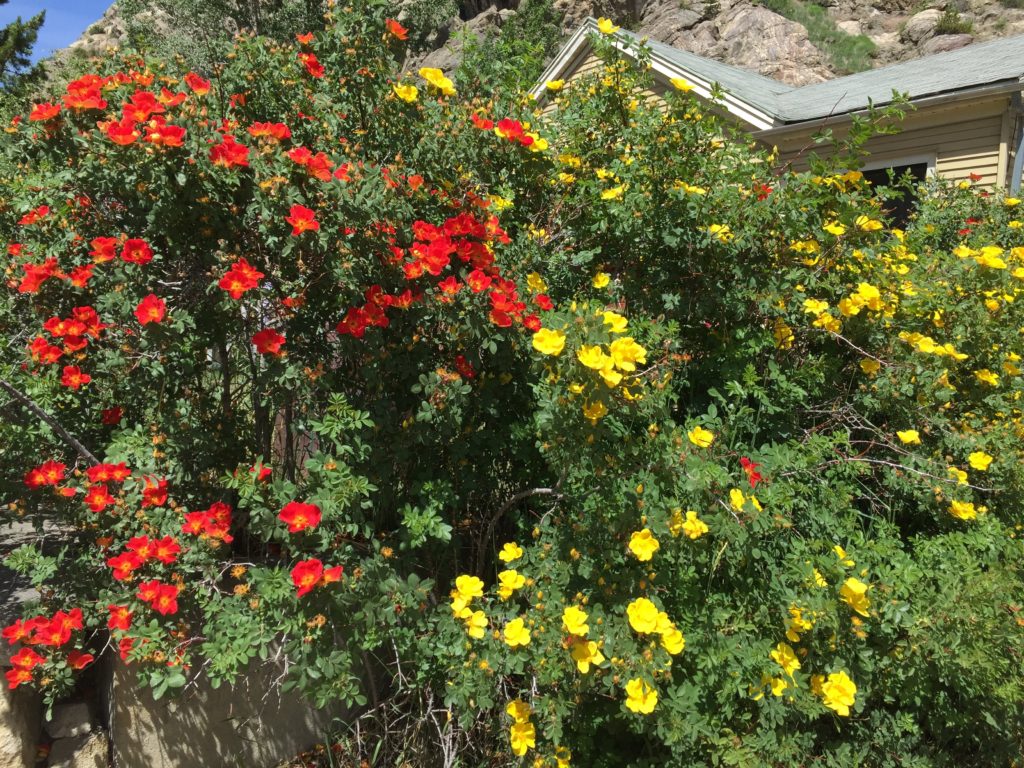
We then took I70 through the Eisenhower Tunnel, which takes you to the other side of the continental divide, and into the towns of Silverthorne and Dillon. Silverthorne services many of the local ski areas. Dillon Lake, which is a a reservoir for Denver (via a pipeline under the divide) is very pretty and ringed by bicycle trails. We took a long and lovely bike ride around the lake, and then drove around trying to find a campsite that was available for the weekend. With no luck on the latter, we drove back to Blackhawk, stopping at the sheep viewing station to see the bighorns.
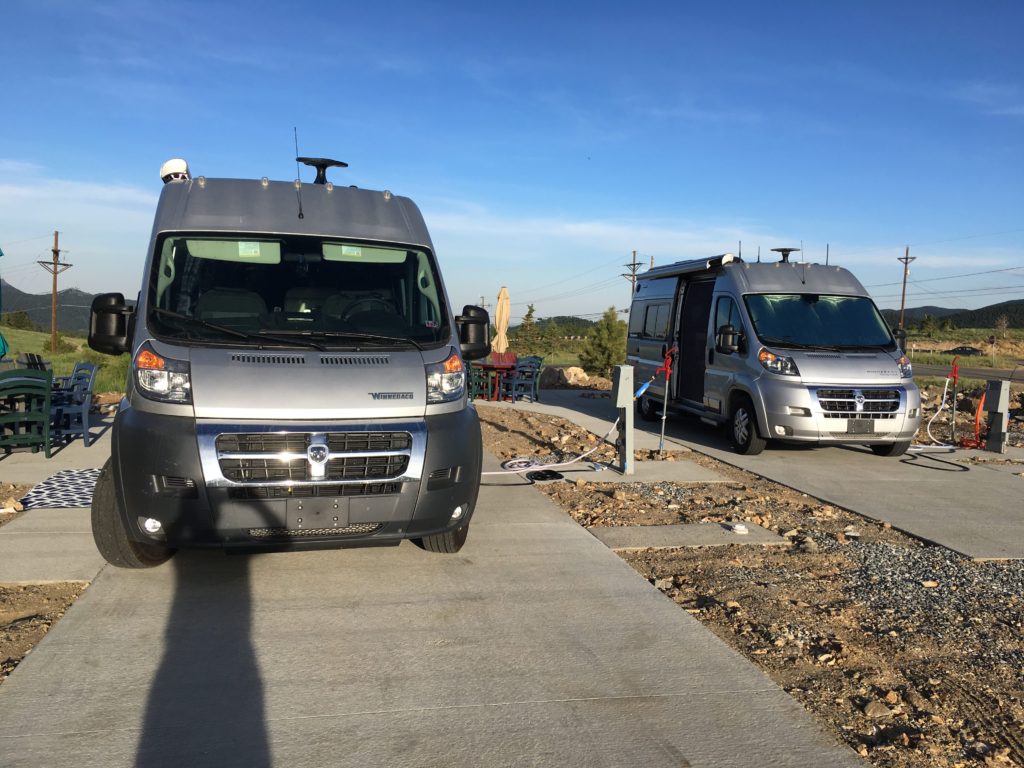
Our camper neighbors had been replaced by Travato neighbors! This was really great, as they had the same model although an earlier year. We spent quite a bit of time discussing upgrades and improvements. In particular, they had some interesting ideas about how to reduce the noise from the airconditioner.
We were rather worried about our lack of reservations for the weekend, as all campgrounds seemed to be full.
However, on one of our stops in Idaho Springs we had seen an advertisement for a bluegrass music festival. Finding it on-line, we discovered that they also had camping for small RVs, so we decided to go.
Friday morning we took VCR to Idaho Springs and then found the festival, which was being held in the town recreational fields. The RV camping was just one of the parking lots, which had been set aside for that purpose.
The festival did not start until 5, so we took the bicycle path from the parking lot, under I70 and back into town. Although I had been perfectly fine during the long (and somewhat hilly) ride in Silverthorne, in about 2 minutes I was totally unable to proceed. I had to sit for about 5 minutes before I could even walk my bike to the top of the hill. I attribute this to altitude. Although my general stance is that I am actually a teenager with a prematurely wrinkled face, I have decided that altitude and age do not mix well — I am therefore being careful not to over-exert.
Once we got to the top of the bicycle path, the remainder of the route was pleasant. The town has a reasonable Chinese restaurant, and the Visitor Center hosts a very good museum about the silver and gold mines that were in the area. We enjoyed both, as well as a side-trip to a grocery store to purchase breakfast foods we could enjoy in our non-electric campsite.
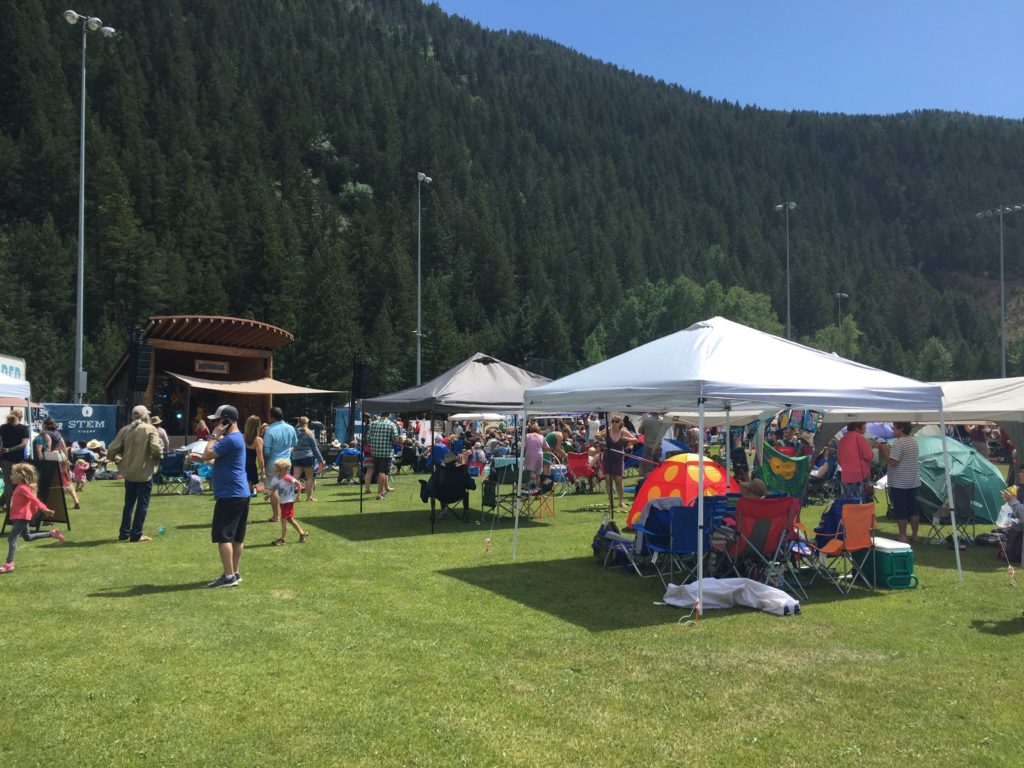
The bluegrass festival was quite different from the two we attended in Centre Hall. Firstly, it was much smaller — starting about 5 on Friday and ending at midnight on Saturday, with at most a few hundred in the audience. Secondly, it was a more mixed crowd both in age and ethnicity. Although we met a number of people from the local towns, we had the impression that most of the crowd drove in from Denver.
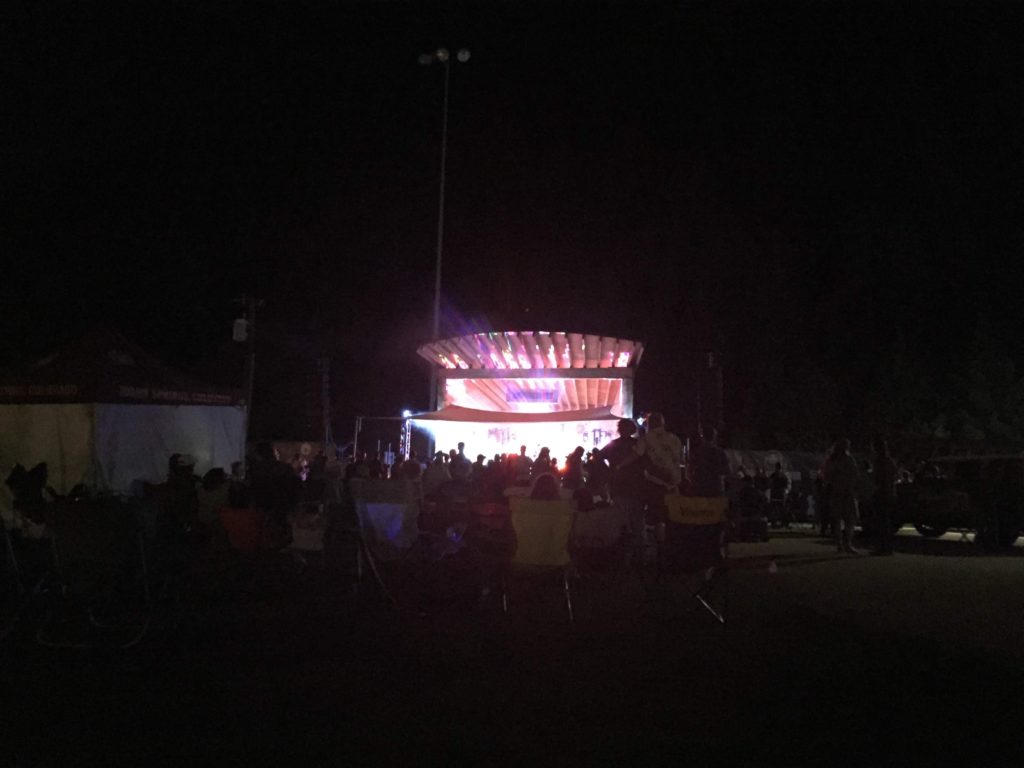
There were a lot of families with young children. There were no Confederate flags (or any kinds of political symbols, unless you consider tie-dye clothing to be political). The festival sponsors included a local brewery and a local cidery that had contributed their product and staff. There were frequent exhortions to eat drink and be merry, particularly to drink beer and cider. We did not see or hear any jamming with or among the audience, although apparently late Saturday night there were jam parties. (It was cold and rainy, so we did not explore that option.)
The music was also very different, although the typical bluegrass instruments were used. Firstly, no gospel (and no talk about religion, except the religion of music). Secondly there was a lot of fusion music – I particularly like something that they were calling “gypsy” style, that sounded to me like klezmer music played on bluegrass instruments. There was also fusion with rock, country etc.
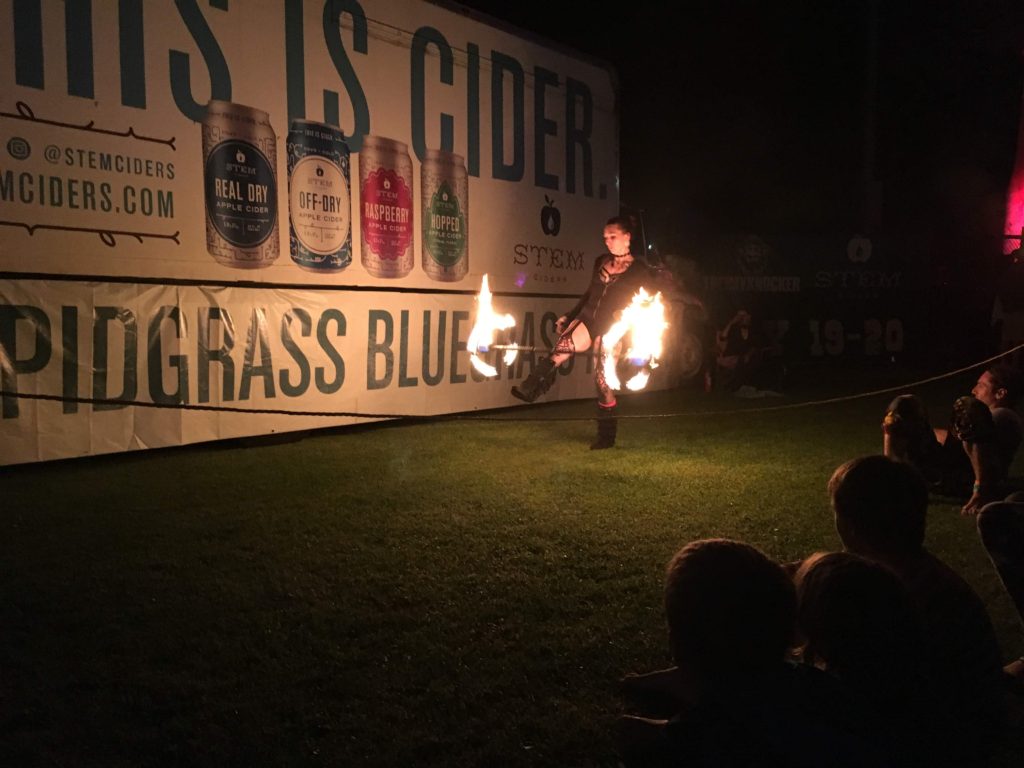
One aspect of the festival we had not seen before was fire performance. This was a group of people I would have to call jugglers, who performed with flaming hula hoops, balls, batons, etc. This was quite amazing (and not advertised).
Except for breakfast, we ate festival food for two days. Pretty good!
On Saturday afternoon the weather turned rainy. Despite thunderstorms, the music continued. The kids were fun to watch — although the adults all huddled under the tents, the kids ran around in the rain and the mud and had a blast. At least one parent came prepared — I saw her son in at least 3 change of clothes (and at last sighting he looked like he had just emerged from the red swamp).
We had a nice chat with one of the festival volunteers, a local woman about my age who loves bluegrass music.
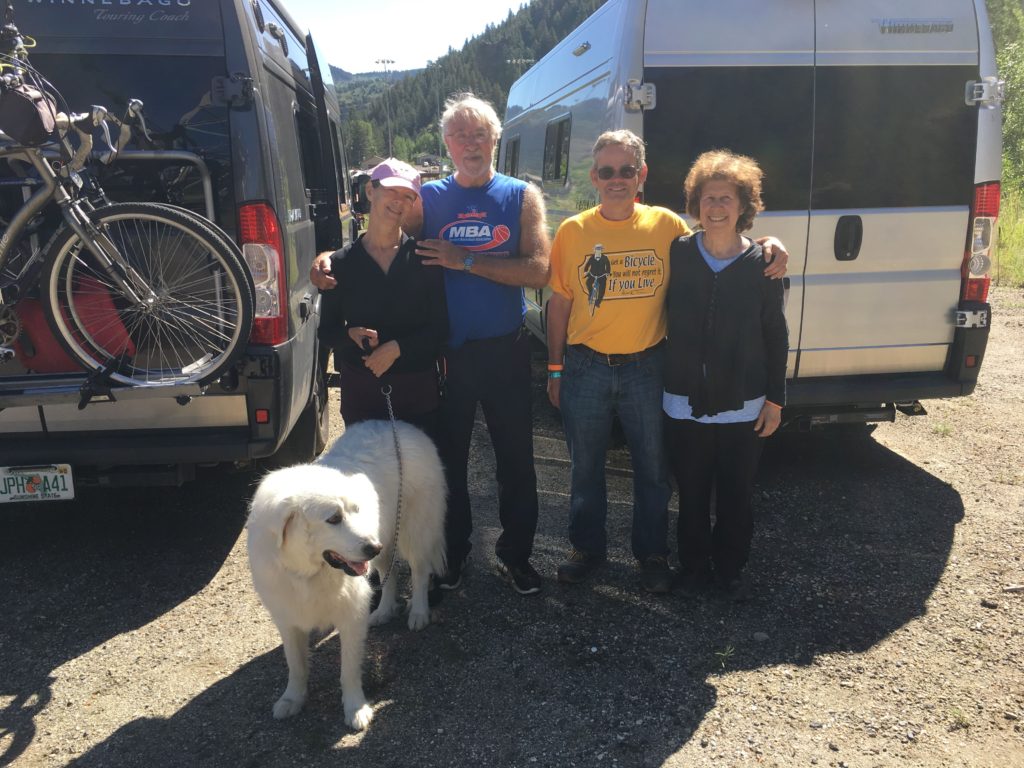
On Saturday afternoon, we were amazed to see that another Travato had parked beside us in the parking lot. They turned out to be a PSU graduate and his wife. They live in Florida now, but lived most of their married lives in Boulder, where he taught personal finance. One of their sons is a bass player in one of the bands. Once again, information and suggestions for living in the vans were exchanged. They had purchased their van 2nd hand and were having transmission problems. Fortunately, that is a van problem, not an RV problem, which makes it easier to find a place to handle repairs.
Of the 3 women we met in the past 3 days, 2 worked in elementary schools and have taken early retirement due to the “evolution” (devolution?) of school policies. One was a school cook. She said that the problem with food provided in the schools is not the food, but the amount of time that the children are given to eat. They are now expected to take school breakfast back to the classroom with them, where they seldom get time to eat before recess. And lunch time is only 20 minutes, which includes the time in line to get the food. As well, much of the food is now packaged for freshness — but the youngest children cannot open the packages themselves and so usually do not eat it. The other was a teacher and school librarian. She had to give up the latter when the state added certification to the librarian position, but gave up teaching due to the emphasis on standardized tests. It seems we are failing at nurturing both body and intellect.
